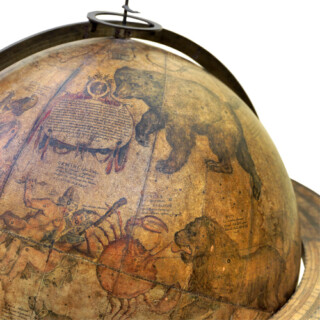[Mughal Ganjifa]
[ANONYMOUS]
[mid-twentieth century].
96 circular playing cards housed in original wooden box.
(diameter) 80mm.
20708
To scale:
notes:
notes:
The Maker
The maker of this set of Ganjifa playing cards remains anonymous.
The Cards
The historic card game of Ganjifa is one of the most variable games, with its spelling, the design of its cards, its suit system, the number of cards and players, and the rules changing depending on when and where it is played. Originating in Persia as early as the twelfth century, Ganjifa became popular across Asia throughout the following centuries, with ...
The maker of this set of Ganjifa playing cards remains anonymous.
The Cards
The historic card game of Ganjifa is one of the most variable games, with its spelling, the design of its cards, its suit system, the number of cards and players, and the rules changing depending on when and where it is played. Originating in Persia as early as the twelfth century, Ganjifa became popular across Asia throughout the following centuries, with ...
The Maker
The maker of this set of Ganjifa playing cards remains anonymous.
The Cards
The historic card game of Ganjifa is one of the most variable games, with its spelling, the design of its cards, its suit system, the number of cards and players, and the rules changing depending on when and where it is played. Originating in Persia as early as the twelfth century, Ganjifa became popular across Asia throughout the following centuries, with India ultimately becoming the last country to produce the cards, mainly in the state of Odisha.
Although rectangular versions are found, Ganjifa cards are recognizable by their circular shape and often ornate designs, which were traditionally hand-painted by artisans. As a popular form of entertainment at the Mughal court, lavish sets were made from materials such as ivory or tortoise shell, before cheaper wooden, cloth or pasteboard sets started to be mass produced for the popular audience.
The cards typically have brightly-coloured backgrounds according to their suits. Although suit systems vary greatly, in most games each suit contains ten pip cards and two court cards: the King and the Vizier. In terms of value, the King is the most highly-ranked card, followed by his Vizier, and then the pip cards from 1 (strongest) to 10 (weakest). An old and influential Arabic variant of the game used the four suits Coins, Cups, Polo-sticks and Swords, while other known versions were played with as many as 30 different suits!
The present cards are an example of the prominent variant, Moghul Ganjifa, played in parts of Odisha with 96 cards in eight suits of 12 cards each. Each deck comprises pip cards from One to Ten, and two court cards: a vizier and a king. The suits used are slaves, crowns, swords, red coins, harps, bills of exchange, white coins and cloth; strangely, this deck does not devote a distinct colour to each suit, there being two yellow suits, two green and two red, as well as a brown and black.
The maker of this set of Ganjifa playing cards remains anonymous.
The Cards
The historic card game of Ganjifa is one of the most variable games, with its spelling, the design of its cards, its suit system, the number of cards and players, and the rules changing depending on when and where it is played. Originating in Persia as early as the twelfth century, Ganjifa became popular across Asia throughout the following centuries, with India ultimately becoming the last country to produce the cards, mainly in the state of Odisha.
Although rectangular versions are found, Ganjifa cards are recognizable by their circular shape and often ornate designs, which were traditionally hand-painted by artisans. As a popular form of entertainment at the Mughal court, lavish sets were made from materials such as ivory or tortoise shell, before cheaper wooden, cloth or pasteboard sets started to be mass produced for the popular audience.
The cards typically have brightly-coloured backgrounds according to their suits. Although suit systems vary greatly, in most games each suit contains ten pip cards and two court cards: the King and the Vizier. In terms of value, the King is the most highly-ranked card, followed by his Vizier, and then the pip cards from 1 (strongest) to 10 (weakest). An old and influential Arabic variant of the game used the four suits Coins, Cups, Polo-sticks and Swords, while other known versions were played with as many as 30 different suits!
The present cards are an example of the prominent variant, Moghul Ganjifa, played in parts of Odisha with 96 cards in eight suits of 12 cards each. Each deck comprises pip cards from One to Ten, and two court cards: a vizier and a king. The suits used are slaves, crowns, swords, red coins, harps, bills of exchange, white coins and cloth; strangely, this deck does not devote a distinct colour to each suit, there being two yellow suits, two green and two red, as well as a brown and black.
bibliography:
bibliography:
provenance:
provenance:







![[ANONYMOUS] [Mughal Ganjifa]](https://omega.crouchrarebooks.com/wp-content/uploads/2025/03/20708_1H.jpg)
![[ANONYMOUS] [Mughal Ganjifa]](https://omega.crouchrarebooks.com/wp-content/uploads/2025/03/20708_2H.jpg)
![[ANONYMOUS] [Mughal Ganjifa]](https://omega.crouchrarebooks.com/wp-content/uploads/2025/03/20708_3H.jpg)
![[ANONYMOUS] [Mughal Ganjifa]](https://omega.crouchrarebooks.com/wp-content/uploads/2025/03/20708_4H.jpg)
![[ANONYMOUS] [Mughal Ganjifa]](https://omega.crouchrarebooks.com/wp-content/uploads/2025/03/20708_5H.jpg)
![[ANONYMOUS] [Mughal Ganjifa]](https://omega.crouchrarebooks.com/wp-content/uploads/2025/03/20708_6H.jpg)
![[ANONYMOUS] [Mughal Ganjifa]](https://omega.crouchrarebooks.com/wp-content/uploads/2025/03/20708_7H.jpg)
![[ANONYMOUS] [Mughal Ganjifa]](https://omega.crouchrarebooks.com/wp-content/uploads/2025/03/20708_8H.jpg)
![[ANONYMOUS] [Mughal Ganjifa]](https://omega.crouchrarebooks.com/wp-content/uploads/2025/03/20708_9H.jpg)
![[ANONYMOUS] [Mughal Ganjifa]](https://omega.crouchrarebooks.com/wp-content/uploads/2025/03/20708_10H.jpg)
![[ANONYMOUS] [Mughal Ganjifa]](https://omega.crouchrarebooks.com/wp-content/uploads/2025/03/20708_11H.jpg)
![[ANONYMOUS] [Mughal Ganjifa]](https://omega.crouchrarebooks.com/wp-content/uploads/2025/03/20708_12H.jpg)
![[ANONYMOUS] [Mughal Ganjifa]](https://omega.crouchrarebooks.com/wp-content/uploads/2025/03/20708_13H.jpg)
![[ANONYMOUS] [Mughal Ganjifa]](https://omega.crouchrarebooks.com/wp-content/uploads/2025/03/20708_14H.jpg)
![[ANONYMOUS] [Mughal Ganjifa]](https://omega.crouchrarebooks.com/wp-content/uploads/2025/03/20708_15H.jpg)
